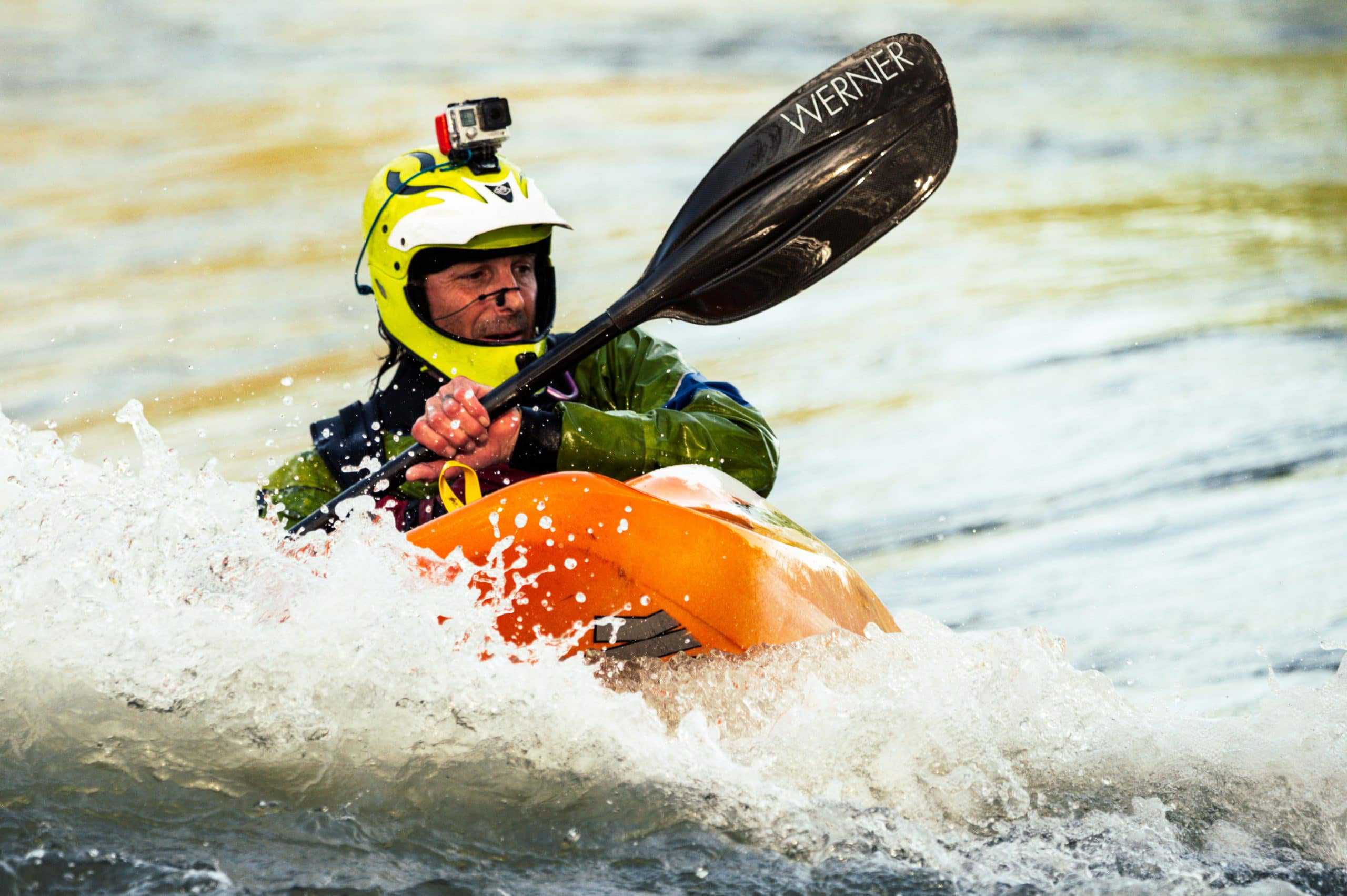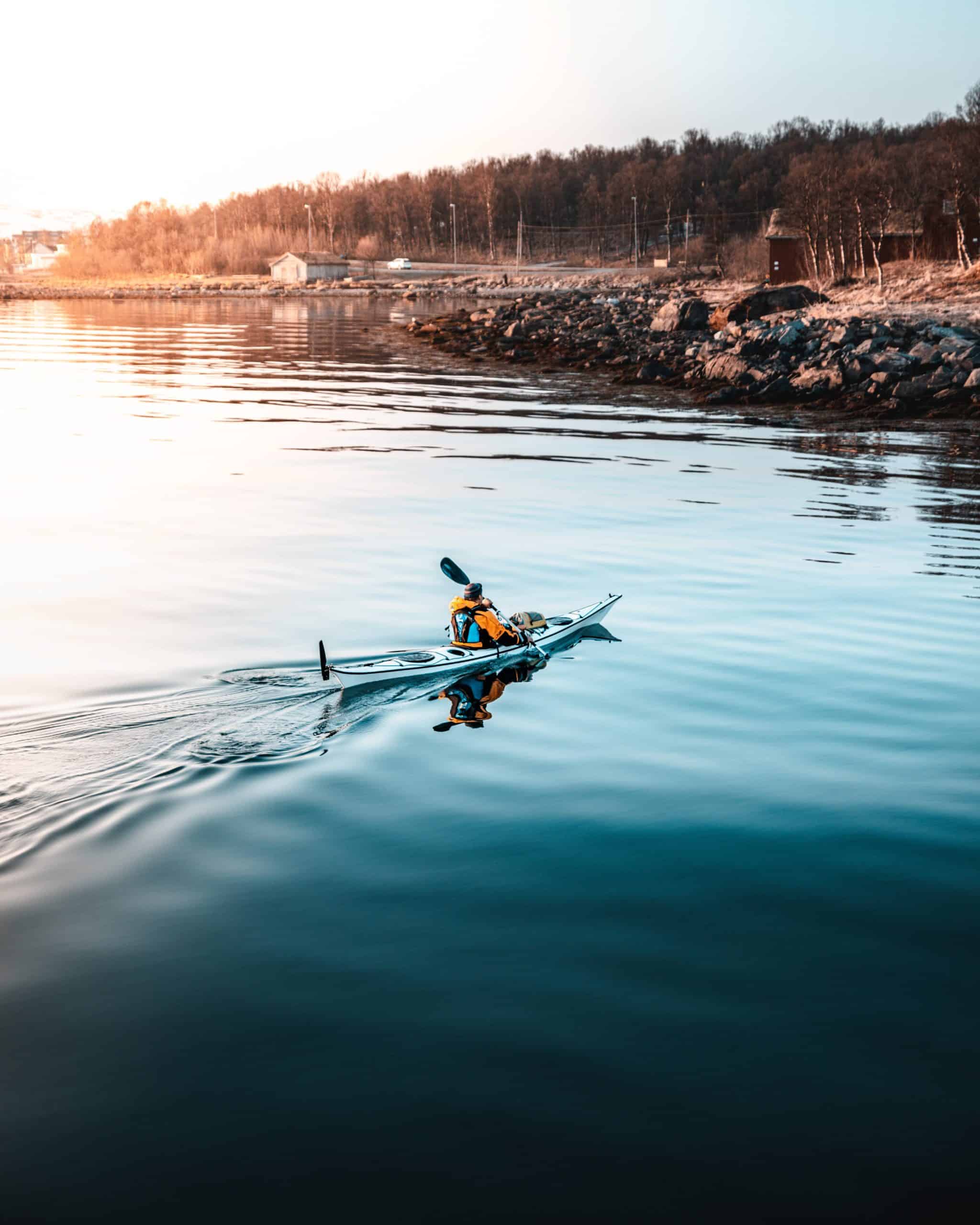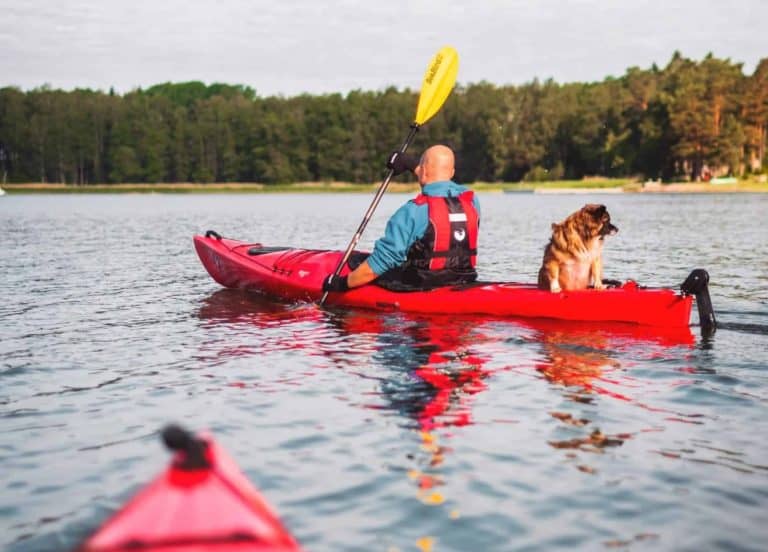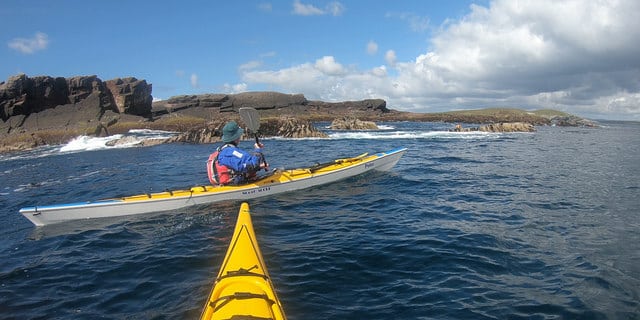Best PFD For Kayaking In 2025: Reviews & Buyers Guide
What is a PFD? PFD stands for Personal Flotation Device. They’re sometimes referred to as life jackets or buoyancy aids, and they prevent the wearer from sinking in water.
PFDs are commonly used on boats or to assist less confident swimmers. Kayaking PFDs are extremely important: in 84% of fatal drowning cases (USCG, 2014) the victim was not wearing a PFD.
We’re here to help, and we’ll be looking at the best PFD for kayaking to help you find the perfect one for your next paddle!

Table of Contents
Best PFD For Kayaking: Top 7 Picks
Pros
- Large armholes that allow you to paddle easily- perfect for kayaking! This also helps you cool down easily.
- The bottom of the PFD is mesh, so it doesn’t ride up but also prevents any bulk from getting in the way of the kayak seat.
- There’s a large pocket which you can expand, to keep things you need close by.
- Fluorescent and reflective material.
Cons
- Only suitable for people over 90lbs, so it cannot be used for young children.
Pros
- It’s designed to be as adjustable as possible. There are four straps on the side to fit your waist, and you can change the shoulder straps. This means that it’s much less likely to slide off but you can also prevent it from feeling uncomfortably tight.
- The shoulder straps are specially made to sit away from your neck so you can move easily without any kind of chafing.
- There are reflective strips so you can kayak in low light levels and still be easily seen by other boaters.
Cons
- Again, this may not be suitable if you have breasts. It is designed to fit tightly across the chest and this design does not seem to account for different chest shapes and may become uncomfortable quickly.
Pros
- It doesn’t ride up. Provided you’re able to find one that fits right, it should stay in place and not get in your way by sliding up into your armpits.
- It’s lightweight and dries quickly. If you’re keen to avoid something bulky that will take hours to dry, this is likely to be a good option for you. In turn, fast-drying PFDs don’t get smelly and are much nicer to transport than damp ones.
Cons
- There aren’t any pockets! Anyone who regularly buys women’s clothing knows that finding anything with decent pockets is extremely hard.
Pros
- Customer reviews show that many people claim that this is nice to wear, to the point that you forget that you’ve got it on.
- There are open sides to allow for ventilation. If you don’t want to cool down in the water because splashing might scare fish, you can try this as it has no padding under the arms and down the sides. This allows you to get some fresh air and avoid sweating too much.
- There are useful pockets that are specifically made for different fishing equipment. It’s hard to transport objects on kayaks (compared to canoes) but this means that you’ve got everything you need extremely close. The pockets are also designed to drain quickly, so you don’t need to worry about your stuff getting wet and smelly after a long time if you do fall in.
Cons
- It’s more expensive than some other models. A good PFD is an excellent investment, but you may be able to find a different one that will do the same thing and not cost as much.
- It doesn’t come with the fishing equipment, so the items you own may not fit in it.
- There is a bulk of buoyant material at the back of the jacket. This is likely to make you hunch forward and potentially affect your kayaking ability.
Pros
- It’s extremely durable. This PFD is designed to last for a long time and still retain its quality. You’ll need to make sure that you don’t use it outside its warranty, but it’s likely to stay in a good shape for a long time.
- It’s got a break in the back panel to prevent you from getting too hot. You’ll often see back sweat start to come through shirts along the spine from where the neck meets the back. In this PFD you can cool down and dry off much more easily because of the mesh inserts.
- There are pockets in the front to keep anything you need in, including one that opens up and can store a drink. Make sure the lid’s on before you start paddling!
Cons
- If you’re a woman, you can either choose to use the female version which is more likely to fit your figure, or this one, which has pockets.
- It’s also bulky. Despite the floatation material being thinner than some other designs, users have still found that it’s more difficult to move in this. The bulkiness becomes annoying after some time in the water, so you may not be able to use this for longer trips.
Pros
- It has pockets! There are two, one on each side and they’re large enough to fit a few small items in each.
- It won’t ride up. It can be adjusted at the bottom of the foam at the back and again at the bottom of the mesh. This keeps it anchored and prevents annoyance, discomfort, and physical impairment that may occur when PFDs don’t stay in place
- This also dries fast. The material should not stay damp for long, which is good as it is unpleasant to be encased in something clammy.
Cons
- Some users said that the material got uncomfortable and felt abrasive. This can be avoided by wearing a swim shirt (or a regular shirt) underneath- which might prevent uneven tanning- but isn’t great for people who prefer to kayak in bikini tops or crop tops.
Pros
- This jacket will fit adults and children. If you buy it for a child it will continue to work for them as they grow.
- It’s bright and colorful. This is good for children who like colorful things, but more importantly, means that you’re easier to spot if you’re kayaking in low light levels and it won’t be hard to find you if something bad does happen.
- The back of the PFD is mesh, so you’re unlikely to overheat even when it does inflate.
- There are thigh straps to stop the vest from riding up. These can be unclipped and not used if you prefer.
Cons
- Some people struggled to use this product. Between not understanding the thigh straps and not knowing how to inflate them properly there were some issues. Make sure you read the information thoroughly before you use this.
- You inflate this model by blowing it up with your mouth. This could be an issue if you are already struggling to breathe or keep your head above water.
- This model is only suitable for people who can already swim. It may not help you if you capsize your kayak and are knocked unconscious.
How to choose the best PFD for kayaking

Firstly, you’ll need to think about yourself and the type of kayaking you like to do. Would you consider yourself a confident swimmer? Are you likely to paddle in the sea, or in large lakes? Would you prefer white water, with the understanding that there’s more likely to rock? Let’s start by breaking down the three main types of PDF:
Standard PFD:
Standard PDFs are the most commonly used. If you don’t own a kayak and regularly rent one from a nearby watersports center, this is what they’re likely to have. They tend to fit like a waistcoat or vest with a zip down the middle, and they’re usually made of foam. Standard PDFs should also have straps so you can adjust them to fit comfortably- more on that later!
Standard PDFs are pretty low maintenance. Dry them off when you’re not wearing them in an airing cupboard or on a washing line and they should last a reasonable amount of time- you should check the life expectancy as it will vary from model to model.
They’re also easy to use because once they’re on they don’t need to be activated in any way. As soon as they’re in the water you’ll be buoyant. You can use them for any kind of paddlesport, including kayaking, canoeing, paddleboarding/SUP’ing, and even water-skiing!
If you like to do lots of different water sports, a PFD will be perfect for you. Finally, some have waterproof pockets so you can easily bring small drinks or snacks, sun cream, or your GoPro!
However, some people are less fond of standard PFDs because they’re always bulky. So much of kayaking depends on your maneuverability and balance and standard PFDs can get in the way of this. They’re also restrictive, which can be a little annoying.
Finally, standard PDFs can get warm, particularly if you’re paddling hard on a summer’s day. This is easy to solve, though: get in the water to cool down! You’ll float nicely thanks to your standard PFD.
However, some people are less fond of standard PFDs because they’re always bulky. So much of kayaking depends on your maneuverability and balance and standard PFDs can get in the way of this.
They’re also restrictive, which can be a little annoying. Finally, standard PDFs can get warm, particularly if you’re paddling hard on a summer’s day. This is easy to solve, though: get in the water to cool down! You’ll float nicely thanks to your standard PFD.
Inflatable PFD:
Inflatable PDFs are new and less well known. Basically, they go over your clothes/bathing suit/skin and are relatively thin, like a regular T-shirt. There are two types of inflatable PFDs: manual or automatic.
A manual PFD will have a cord that you pull. This activates a CO2 cartridge and inflates the PFD. The automatic PFD does the same thing but you don’t have to pull the cord, as it will happen when you are in the water.
For this reason, some paddlers prefer manual inflatable PFDs, because they may be activated by splashing. Inflatable PFDs are also called Type III or Type V USCG-approved PFDs, depending on the design.
Inflatable PFDs are lightweight and comfortable. You won’t have any limits to your movement like you would with a standard PFD, so inflatable PFDs are often favored by paddlers on SUPs.
You’ll also stay cooler without having to get into the water.
However, there are some downsides to inflatable PFDs. You can’t wear one if you’re likely to be knocked unconscious as you won’t be able to inflate it if it’s a manual inflatable PFD.
You can use them for kayaking, but not whitewater kayaking. If you do other watersports activities you can’t use an inflatable PFD for whitewater canoeing, water skiing, or river rafting.
They’re also not suitable for children or anyone who can’t swim, although it’s good to be able to swim before you start any kind of watersports. Inflatable PFDs will also require some maintenance because you’ll need to replace the CO2 cartridge every time it inflates.
Hybrid PFDs are, as the name suggests, a combination of both inflatable and manual PFDs. They’re unusual and expensive, but they’re also buoyant and comfortable.
The specifics of each design will vary with the make, so you should check carefully how much upkeep it will require and which activities you can do with it.
Best PFD for kayak – FAQs
What are the advantages of using PFDs?
The most obvious answer is that you’re more likely to survive an otherwise fatal accident. Safety gear is usually the least fun part of any kind of outdoor activity, but it’s extremely important.
Even kayakers who are confident, good swimmers and know the areas they’re paddling in will sometimes get into trouble, and making sure that you’re always prepared keeps you safe.
They’re also easier. If your boat does capsize and you’re not wearing a spray deck, wearing a PFD will mean that you can swim easily out, get your paddle, right your kayak, and pull everything to the edge of the water with much less effort than if you’re trying to swim unaccompanied.
What are the disadvantages of using PFDs?
They’re bulky. Some of them. In a way that you probably won’t notice after a few minutes. That’s it really.
Occasionally people (especially children) won’t want to wear PFDs. If you’re about to kayak with someone who would rather not wear a PFD, explain to them that they’ll be much safer and that it’s not fair on the rest of the group to try and rescue them if something does go wrong, especially as it might put someone else in danger.
If a child is fussing, either tell them that they won’t be allowed to go or help them find a PFD which is appealing to them- they come in a variety of shapes and colors, so if they’re uncomfortable then adjust.
One final thing to consider…
If you like to kayak with a splash deck, please take some time to work out how the two will fit together. If you’re wearing a PFD that comes down low, be aware that they may get in each other’s way and prevent either from working effectively.
Conclusion – Best PFD For Kayaking
Finding the right PFD for you is a difficult task, but it’s absolutely essential that you do it right. Where possible, buy from a watersports store so you can try them on easily: failing that, find something with a decent returns policy so you make try them on and give them back if they’re not right.
Also, try them in ‘safe’ water first- possibly a swimming pool or a lake without any currents and within your depth. Make sure you keep an eye on the warranty and remember to replace or carefully repair any damage before using your PFD again.
Final Recommendations:
For women- the O’Brien is the best. It doesn’t look as bulky as the other option, which can be really annoying. It’s also more obviously adjustable, which means it’ll be good for women with unusual figures and won’t slip off too easily.
For men- the Onyx Move Vent is the best. It’s extremely durable, which will be ideal for frequent paddlers. It also has some very useful pockets, for any additional gear you want to take out on the water.
Related Kayaking Posts:
- Kayak Rudder Kits: Top Picks & How-To Install
- How To Store A Kayak In A Garage – Different Options
- Best Kayak Trolling Motors: 5 Reviews & Buyers Guide (2023)
- Kayak Truck Racks – Best Options & Buyers Guide
- Best Kayak Fishing Crates For Easy Kayak Storage
- What Is A Scupper Plug & Do You Need Them In Your Kayak?
- Paddle Board VS Kayak – Which Is Best For You?
- Best Kayak Cooler For Ice Cold Storage In 2023
- Best Kayak Carts, Wheels & Trolleys You Should Use In 2025
- Intex Challenger K1 Review – Inflatable Kayak Guides

![7 Best Ice Fishing Bibs [Reviews & Buyers Guide]](https://watersportingadventure.com/wp-content/uploads/2020/10/Ice_fishing_December_Zanderland_Finland-e1606491519613.jpg)
![7 Best Fishing Pliers [In-depth Reviews & Buyers Guide]](https://watersportingadventure.com/wp-content/uploads/2020/10/pexels-shane-kell-2431454-scaled-e1602751936800-768x336.jpg)
![8 Best Freediving Fins [Product Reviews & Buyers Guide]](https://watersportingadventure.com/wp-content/uploads/2019/12/1-e1602774493423-768x368.jpg)
![Best Fishing Kayak Under 300 [Top 8 Sit On Top Kayaks]](https://watersportingadventure.com/wp-content/uploads/2020/02/Kayak-fisherman-tif-e1610121026375-768x446.jpg)

